Public Spaces
Friday, October 1st, 2021
What doors are required to comply with ADA?
There seems to be a confusion about which doors are required to comply with the Americans with Disabilities Act. Most people understand that doors that lead you to accessible public spaces and rooms have to comply. But many don’t realize that ALL doors that allows “user passage” must comply with the standards. There is just one exception: a door that allows user passage but it is leading into a room that is exempted from accessibiltiy (i.e. a machinery space).
Knowing that information, let’s delve into what doors are required to comply and what are the requirements.
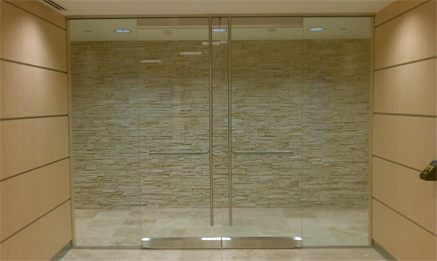
Doors that allow user passage like the one shown above must comply.
Which Doors must comply?
In section 206.4 of the ADA it gives us the requirements for which type of doors must be accessible.
206.4 Entrances. Entrances shall be provided in accordance with 206.4. Entrance doors, doorways and gates shall comply with 404 and shall be on an accessible route complying with 402
206.5 Doors, Doorways, and Gates. Doors, doorways, and gates providing user passage shall be provided in accordance with 206.5.206.5.1
This paragraphs lets us know that only entrance doors are going to have requirements. Exit doors are not fully exempted. The door to “exit” a space is technically an “entrance” to the exit. Therefore the side of the door which allows user passage must also comply.

Even though this is a means of egress door and has limited requirements in the ADA Standards, it is considered a door that allows user passage and must comply.
206.5 continues to tell us which spaces must have doors that comply:
- Each entrance to a building or facility (there are some restrictions, so be sure to understand them)
- Within a building at least one door serving each room (even work areas)
- In transient lodging facilities all entrances providing user passage into and within guest rooms that ARE NOT required to provide mobility features (but only the clear width)

This floor plan shows a hotel room that is not required to have mobility features. All doors (except the shower door) which allows “user passage” into and within the room must comply. A 32″ clear width should be provided. All other requirements are not mandated.
A common misunderstanding is the term “user passage”. A user that they are describing is not only people who use wheelchairs, but also ambulatory and able bodied users. Therefore even if the room where the door is located is not large enought for a wheelchair, the door clear width into the room must still comply. Note the water closet room. That door must also comply with providing at least a 32″ clear width, even if the room is not large enough for a wheelchair to enter.

This storage closet appears to be the type that allows user passage, and therefore the door must comply with the techical requirements.
What are the technical requirements?
To find the technical requirements we look in section 404 which explains how to make the required doors accessible.
Doors, doorways and gates must meet the following standards:
- Must have a clear width of 32″
- Must have proper maneuvering clearances to allow for a person to open the door and go through
- The floor and ground surface at the maneuvering clearance must be stable, firm, slip resistant and must have a slope no steeper than 1:48
- A threshold that is not higher than 1/2″ must be provided
- The hardware must be the type that does not require tight grasping and twisting of the wrist, plus must be mounted between 34″-48″ a.f.f.
- The door should not close too fast (no faster than 5 seconds)
- The opening force should not be too heavy (no more than 5 lbs on an interior door)
- The bottom surface at the push side should be smooth
- If it has a vision light it should be mounted no higher than 43″ a.f.f. (a peep hole is not a vision light)
- And if there is an automatic door, there are some additional requirements (under 404.3)

This door had a clear width of 28 1/2″. The minimum requirement is 32″ clear

This picture shows the proper maneuvering clearance to reach the door handle and to go through the door
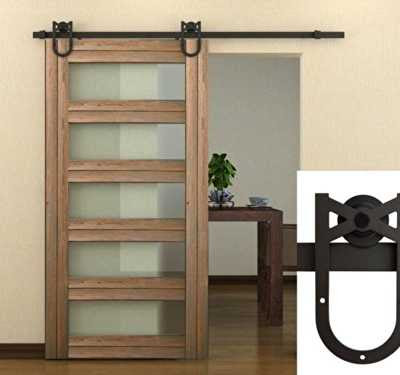
Even sliding doors are required to have maneuvering clearance. The only ones that will not is for shallow closets that do not provide user passage

This video shows you the requirements for door maneuvering clearances
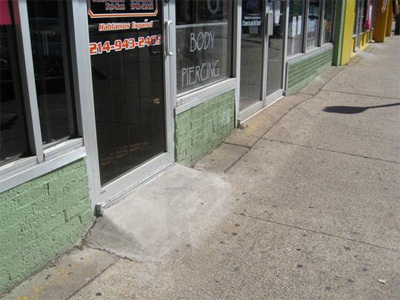
The door shown above has a slope steeper than 1:48 at the maneuvering clearance, and a threshold higher than 1/2″

The door shown above has hardware that requires tight grasping and twisting of the wrist to operate
A dining counter has a forward approach knee clearance and it is 34″ a.f.f.


The door hardware in this door was mounted at 61″ a.f.f. (higher than the allowed 48″ a.f.f.)
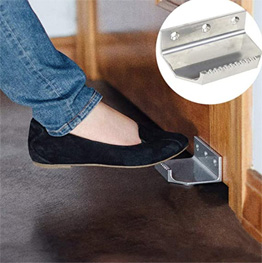
Because the push side of the door must have a smooth surface, a foot opener cannot be used on the push side
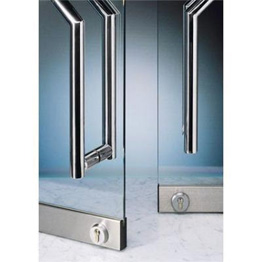
In addition, the door hardware on the push side of the door must not be lower than 10″ a.f.f.

The vision light shown above was mounted higher than 43″ a.f.f. to the glazing.
Wednesday, September 1st, 2021
Section 810.2 Bus Loading Zones
This newsletter will speak about Bus Loading Zones both in the Public Right of Way and inside a property (like a school or other facility).

The bus stop in the above picture does not show the proper requirements for loading and unloading. This newsletter will explain why

The bus stop in the above picture is at a school and appears to have the correct area for loading children with disabilities
Technical Requirements
Bus loading zones must have an area that 96″ long measured perpendicular to the curb or vehicle roadway edge, and a clear width of 60 inches (1525 mm) minimum, measured parallel to the vehicle roadway.

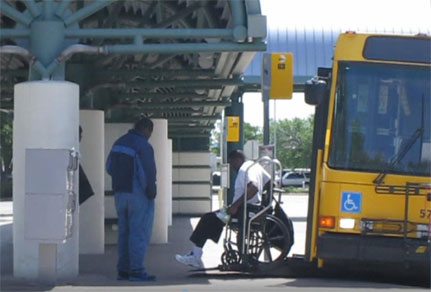
The video above shows why the 96″ long area parallel to the curb is required. The lift mechanism for a wheelchair user to enter and exit the bus requires that amount of space.
If there is a bus shelter there should be a path of travel from the bus shelter to the loading area. The path needs to be a minimum of 36″ wide. There should be an area inside the shelter that is 30″x48″ with a slope of no greater than 1:48

Parallel to the roadway, the slope of the bus stop boarding and aligning area shall be
the same as the roadway, to the maximum extent practicable. Perpendicular to the roadway, the slope of the bus stop boarding and alighting area shall not be steeper than1:48.
It is important to note the last requirement: The slope at a bus loading zone that is parallel with the road can be the same as the roadway and is not required to be 1:48

This bus loading zone does not have a 96″ long space parallel with the curb
Monday, August 2nd, 2021

Accessible Work Areas
Thank you to Marsha Godeaux from TDLR for taking the time to explain about employee work areas. Click here to watch the video.
This newsletter will cover Employee work areas. There is a misunderstanding that work areas are not required to comply with the ADA or TAS Standards. We will explain what is required to comply within work areas and what is exempted. Keep in mind that the requirements we are covering are only the 2010 ADA Standards and the 2012 Texas Accessibility Standards. The ABA which covers Federal Facilities do not have the same requirements.
What is a Work Area?
Employee Work Area. All or any portion of a space used only by employees and used only for work. Corridors, toilet rooms, kitchenettes and break rooms are not employee work areas.
Work Area Equipment. Any machine, instrument, engine, motor, pump, conveyor, or other apparatus used to perform work. As used in this document, this term shall apply only to equipment that is permanently installed or built-in in employee work areas. Work area equipment does not include passenger elevators and other accessible means of vertical transportation.

Work cubicles are part of a work area

a Point of Sale counter is considerd a work area as long as the public is not required to approach it.
What are the requirements?
203.9 Employee Work Areas. Spaces and elements within employee work areas shall be designed and constructed so that individuals with disabilities can approach, enter, and exit the employee work area.
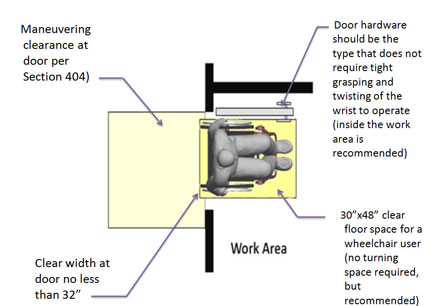
The image above summarizes the approach, enter and exist requriement
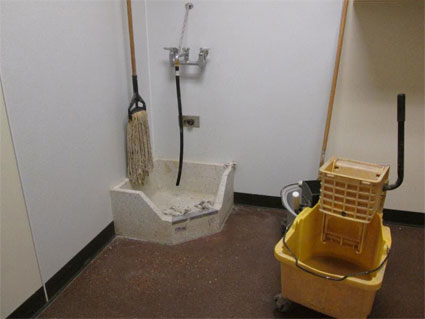
An example of a work area that only requires an approach, enter and exit would be a janitor’s closet. Elements within the janitor’s closet such as the faucet for the mop sink will not be required to comply.
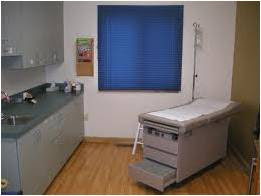
An exam room is partially a “work” area and partially a “patient” area. The area that is only used by the doctor (the sink) will be exempted from having to comply.
What are some exceptions?
Employee work areas, or portions of employee work areas, other than raised courtroom stations, that are less than 300 square feet and elevated 7 inches or more above the finish floor or ground where the elevation is essential to the function of the space shall not be required to comply with these requirements or to be on an accessible route.
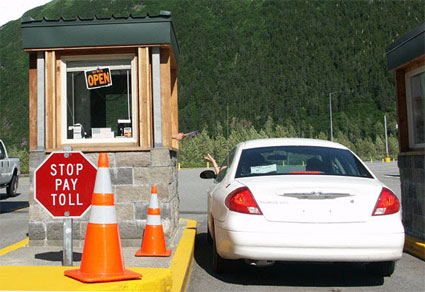
This toll booth is less than 300 s.f. and elevated more than 7″ a.f.f. and therefore do not require an accessible route to it or the ability to approach it and enter it.
Common Circulation Path
In addition to approach, enter and exit, if the employee work area is larger than 1,000 s.f.. then a common path within the work area to common use spaces shall be provided
206.2.8 Employee Work Areas. Common use circulation paths within employee work areas shall comply with 402.

A “common” circulation path is one that is used by more than one person and not intendend for work
Section 402 states that a minimum 36″ width shall be provided along the circulation path.
EXCEPTIONS:
1. Common use circulation paths located within employee work areas that are less than 1000 square feet (93 m2) and defined by permanently installed partitions, counters, casework, or furnishings shall not be required to comply with 402.2.

This raised work area is allowed since the work area is less than 1,000 s.f.
If the path is around work area equipment, then it will not have to comply with the 36″ clear width.

This commercial kitchen has equipment that is an integral part of the work area. The 36″ min. circulation path in this space is not required to comply due to the location of the work area equipment.
Protruding Objects
Even though the only requirement for a work area is “approach, enter and exit”, it also requires that circulation path be provided. Part of the circulation path has to make sure there are no protruding objects projecting onto the circulation path more than 4″. This requirement are for any employee or visitor to the employee area that might be visually impaired.
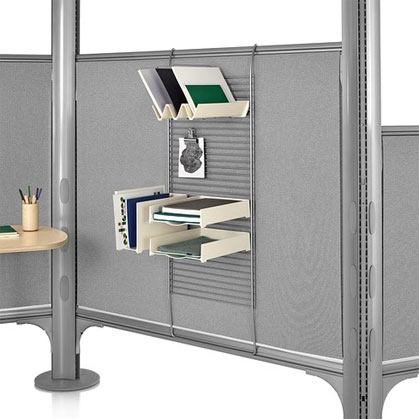
the filing system is located along the common circulation path inside the office space and projects more than 4″ onto the circulation path.
What about other employee areas that are not work related?
The requirements thus far have been for areas that are considered part of the “work” areas in a space. But there are other areas that are also part of an employee area, but are not related to the work they perform. Those areas that are NOT related to their job description will not be exempted and must comply. Below are a few examples of areas that might be for employees only, but must be fully compliant with the Standards:
Break Rooms
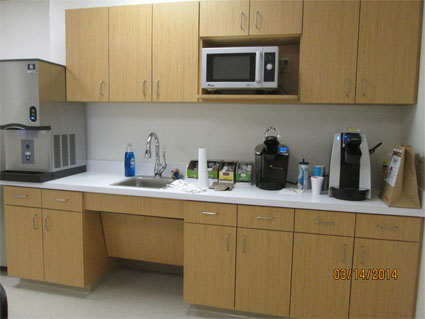
even though a break room is not a public area, it is still required to comply with the ADA and TAS because it is not considered a “work” area, but rather a space where they take a break from work.
LEED employee shower and employee restrooms

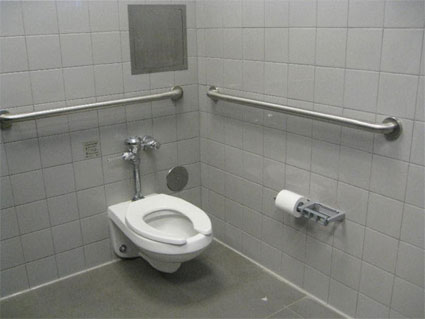
an employee shower or even an employee restroom are also not considered “work” areas and must comply.
Employee Locker Room
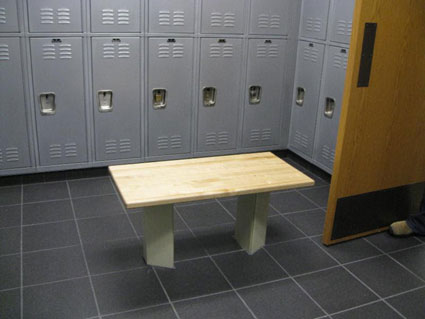
The lockers as well as the bench in this locker/dressing room must comply with the Standards
What happens when an employee is disabled?
The Standards sometimes provide additional guidance through “advisories”. These are NOT requirements, but they are suggestions that might make your design a better one. Below are some of the advisories on work areas:
Advisory 203.9 Employee Work Areas. Although areas used exclusively by employees for work are not required to be fully accessible, consider designing such areas to include non-required turning spaces, and provide accessible elements whenever possible.
Under the Title I of the ADA, employees with disabilities are entitled to reasonable accommodations in the workplace; accommodations can include alterations to spaces within the facility. Designing employee work areas to be more accessible at the outset will avoid more costly retrofits when current employees become temporarily or permanently disabled, or when new employees with disabilities are hired.

Thursday, July 1st, 2021
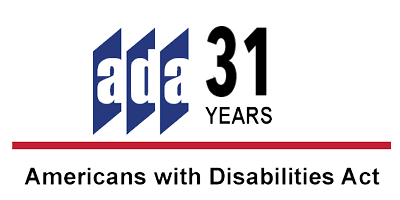
Abadi Accessibility is proud to support the Americans with Disabilities Act (ADA) 31st Anniversary. On July 26th we celebrate this important civil rights law that works to ensure all people with disabilities have the same rights and opportunities as everyone else. Celebrate with us by visiting: www.adaanniversary.org/ #ADA31 #ThanksToTheADA
How are you planning to celebrate Americans with Disabilities Act (ADA) 31st Anniversary? This July 26th the ADA National Network and individuals, communities, and organizations across the country will be participating. Learn how you can be involved by visiting www.adaanniversary.org/ #ADA31 #ThanksToTheADA
Introduction to our newsletter:

After I wrote my first newsletter about counters, my clients are still not clear on all the different requirements for the different types of counters and fixed or built-in surfaces that the ADA requires to be accessible. First of all let me review that there are five type of counters scoped in the ADA Standards: Work surfaces, dining counters, service counters, sales counters and check out counters. Then there are two type of counters that are not scoped: work area counters and non-work area common use counters that do not fall under the other listed. There are also Food service lines, as well as other portions public side service areas. For those please check out my newsletter I wrote I 2014.
This newsletter will explain the different requirements for dining surfaces, non-employee work surfaces and sales and service counters.
Dining Counters
According to Scoping section 226, at least 5% of seating spaces and standing spaces at dining surfaces must comply with 902. Standing spaces are those counters where people might stand to eat or drink rather than sit. Those counters must also comply. Some examples of dining counters are bars where drinks are served, fast food establishments with fixed tables, and booths and banquettes at a restaurant.
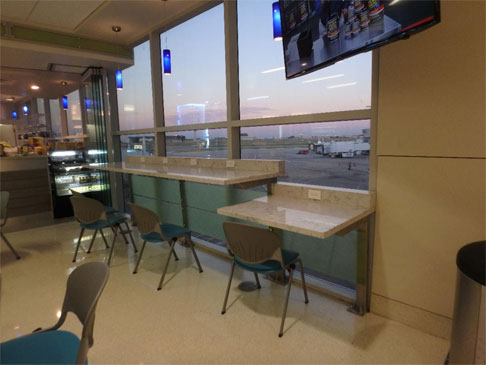
These fixed dining counters in a cafeteria is an example of a dining surface.

a bar is an example of a dining surface
Section 902 gives us direction on how to make the dining surfaces accessible:
- There must be a knee clearance complying with section 306 so that a person in a wheelchair will approach and use the counter in a forward approach
- The height of the counter must be between 28″-34″ a.f.f. PLEASE NOTE….WE RECOMMEND TO NEVER USE THE MINIMUMS OR MAXIMUMS WHEN DESIGNING.
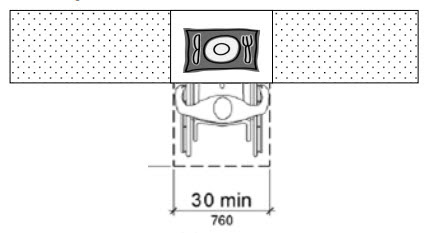
A dining counter should have a 30″ width and a 17″ min. depth at the knee clearance.
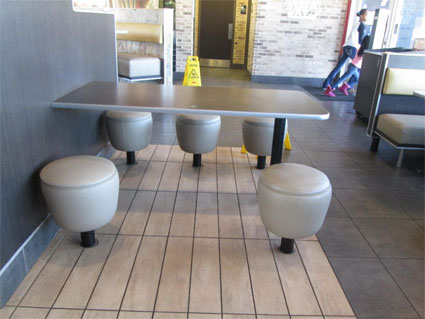
A dining counter has a forward approach knee clearance and it is 34″ a.f.f.
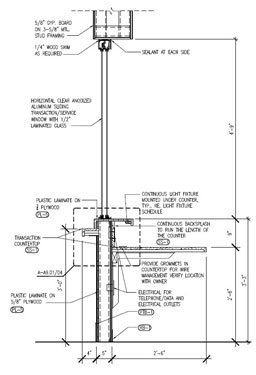
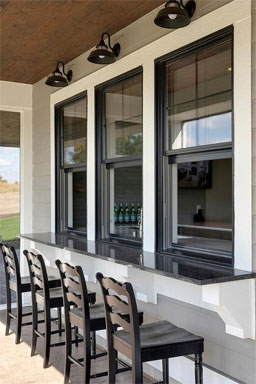
This is a dining counter but also a service window. It is acceptable to have the dining counter in front of the service counter
Non-Employee Work Surfaces
Section 226 tells you that 5% of non-employee work surfaces must comply and meet the requirements set forth in section 902. These are also required to be dispersed throughout the space they are in. Section 902 states that a work surface must have a forward approach with a knee space per section 306 and be 30″ wide minimum and 34″ high maximum
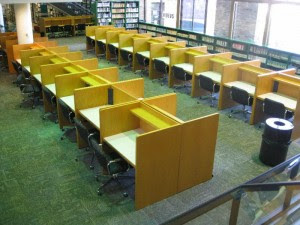
Study carrols in a library is an example of a non-employee work surface
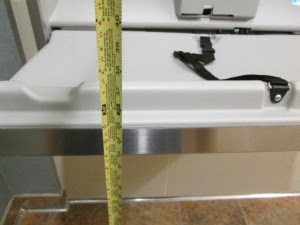
Diaper changing counters are also considered a “work surface”

A patient registration desk is another example of a non-employee work surface
All the requirements in section 902 are for non-employee work surfaces (or for the public). Employee work surfaces that are part of a work area are exempted until such time when a person with disabilities is hired at which point, the surface must be provided to accommodate them and their abilities.
Sales and Service counters
Where provided, at least one of each type of sales counter and service counter shall comply with 904.4.
Where counters are dispersed throughout the building or facility, counters complying with 904.4 also shall be dispersed.
Keep in mind that the requirements are the either sales or service counters. The term “transaction” is no longer used. A transaction could occur but it is not the only pre-requisite for compliance.
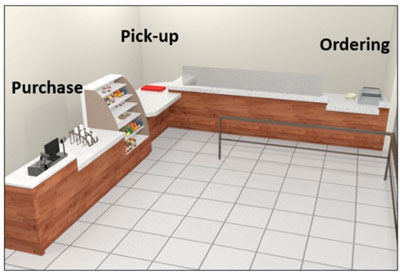
The counter shown above has different functions (some are sales and some are service). Each one must have a portion at an accessible height
Section 904 gives us the following requirements for sales and service counters:
- 36” high maximum
- Same depth as the main counter
- 36” length min.
- Parallel approach OR Forward approach allowed
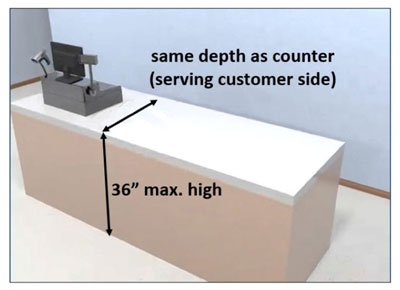
the accessible couter must be 36″ a.f.f. maximum and at least 36″ long

A sales or service counter can have either with a forward approach knee clearance or a parallel or side approach.

The accessible portion of the counter must be the same depth as the main (or public) side of the counter. Even though the reception counter is deeper than the public counter, the accessible portion will only have to be 36″ a.f.f. maximun and 36″ min. long the same depth as the public counter (which can be higher than 36″ a.f.f.)
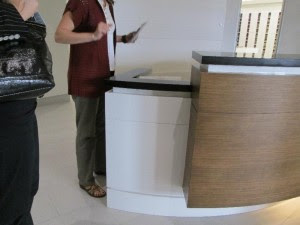
The reception desk is considered a “service” counter because information is a service a business would provide to their guests. The one shown above did not have a 36″ long counter
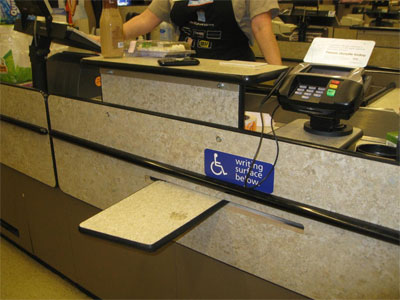
A service or sales counter may not be the type that is flipped up, or pushed in once it is used. it must be a permanent counter that is always available.
Tuesday, June 1st, 2021
Inspector’s Corner
Today’s newsletter I bring you some examples of violations that I found during my on site inspections. These specific ones are violations that were made because the standards were not so well understood. Hopefully these examples will give you some clarity for future installations.
Clearance at the drinking fountains
The drinking fountains that are mounted along a circulation path might be a protruding object if the leading edge is higher than 27″ a.f.f. When the leading edge is higher than 27″ a.f.f. which most of the time it will be the drinking fountains for standing persons, then that drinking fountain will be considered a protruding object. To resolve the violation, we typically see a cane detectable apron installed at the bottom edge of the high drinking fountain. Since the high drinking fountain is not for people in wheelchairs, but for people who are standing but have trouble bending down to drink, a knee clearance is not required. So technically the cane detectable apron could be mounted at any height as long as it reaches a minimum of 27″ a.f.f.
The misunderstanding is of the requirement that the clear floor space of the wheelchair be located centered with the low unit for them to use
602.2 Clear Floor Space. Units shall have a clear floor or ground space complying with 305 positioned for a forward approach and centered on the unit. Knee and toe clearance complying with 306 shall be provided.
So that means that the 30″ clear floor space will be partially located under the high drinking fountain

If the cane detectable apron located at the high drinking fountain is lower than 27″ a.f.f., it will reduce the required knee clearance at the low drinking fountain
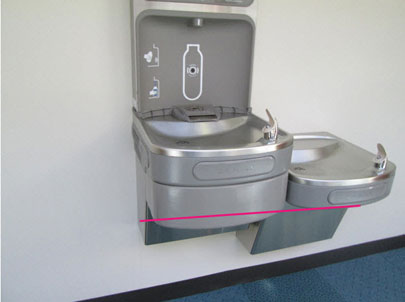
The cane detactable apron is lower than 27″ a.f.f. which reduces the knee clearance which is centered at the low drinking fountain
In order to not have that violation, the cane detectable apron must be mounted exactly at 27″ a.f.f.
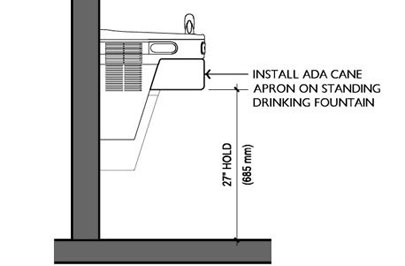
Post-mounted protruding objects
(this is not exactly examples of violations, but rather why it is not a violation)
The rules for protruding objects allows post or pylon mounted obects to project 12″ from its mounting surface. The figure below is from the ADA and TAS section 307.3 which shows the parameters of the protrusion limits.
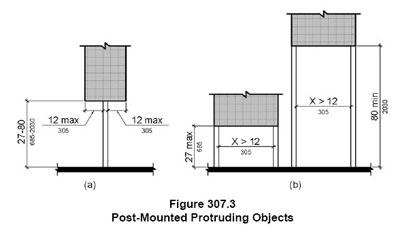
My example is from an interior play area where there was a statue of one of their characters mounted on a pylon or tall base. The statue had a little hand and pigtail that projected beyond the edge of the base. But because the ADA and TAS allows a 12″ protrusion limit along the circulation path, the statue was not a protruding object.
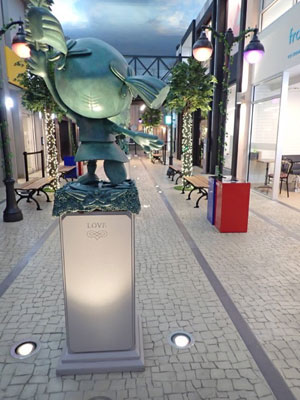

The little hand of the statue projected 6″ beyond the base, which was compliant.
Another example of a post mounted protruding object is a stand pipe located at a means of egress stair landing. Because the means of egress is essentially a circulation path it will require that the protrusion limits that the ADA and TAS describe in section 307 be adhered to.
The stand pipe in the photo below does have an extension where the valve is projecting more 12″ beyond the pipe and mounted higher than 27″ a.f.f.

The stand pipe is a protruding object because the valve projects more than 12″ from the post onto the circulation path
Pendant lights as protruding objects
Sometimes the protruding objects occurs because the object is mounted below 80″ a.f.f. Pendant lights can be protruding objects if mounted too low. The condition shown in the photos below shows a play room with furniture mounted below the pendant lights. The pendant lights are mounted at 70″ a.f.f. and therefore are protruding objects.
But you might be asking why is it a violation since the furniture acts as our cane detection?
Good question…
What is a misunderstanding is that the only cane detection that is allowed must be fixed or buil-in (see the requirement below)
201.1 Scope. These standards apply to fixed or built-in elements of buildings, structures, site improvements, and pedestrian routes or vehicular ways located on a site.
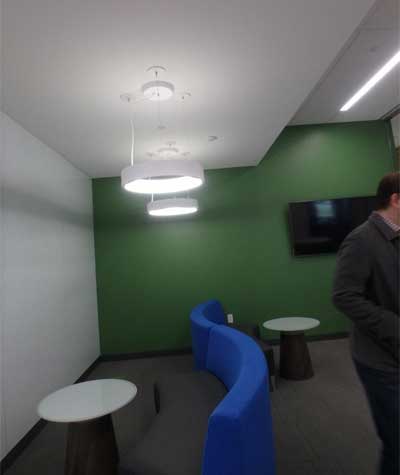
because the furniture below the pendant lights are movable and not built in they cannot be use as cane detection
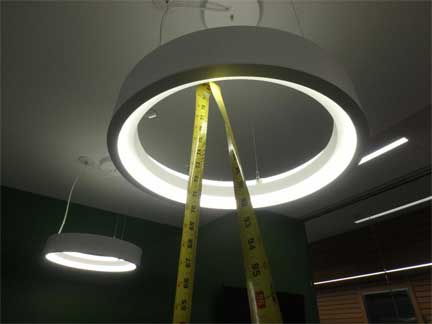
the pendant light is mounted at 70″ a.f.f. and is considered a protruding object
Monday, May 3rd, 2021
The 2010 ADA Standards for Accessible Design (The ADA for short) is sometimes used as a catch-all term for all requirements for designing for persons with dissabilities. What is sometimes misunderstood is that the ADA is a Civil Rights law with design guidelines for public accommodations and commercial facilities. But there are other laws and standards that govern how to design for persons with disabilities that are different from the ADA and still have to be followed. One of the standards are found in the building code. If a municipality has adopted Chapter 11 of the IBC that chapter references another Standards call the ANSI A117.1. The ADA and ANSI are very similar, but there are some differences. In this newsletter I will give you a few examples.
For the sake of this newsletter I wilil be discussing the 2017 ANSI A117.1 Standards. This may or may not be the Standared that has been adopted by the municipality you are designing under and you will need to verify which version you need to follow. Not all the versions have the same requirements.
304 Turning Space
Both the ADA and ANSI A117.1 have requirements for the size of a circular turning space. They used to be the same (60″ diameter), but In the 2017 version of the ANSI the size increased to 67″ min.
Below is the new figure for the 2017 ANSI
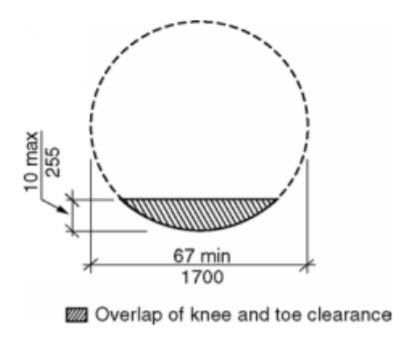
604.5.2 Rear Wall Grab Bar
Both in the ADA and the ANSI the section that discusses the rear wall grab bars is 604.5.2 But the location of the grab bar is measured differently in the ANSI than in the ADA. this confuses most installers and we typically find ADA violations based on the assumption that they are both the same.
Note the figure below. It is from the 2017 ANSI A117.1 604.5.2
It shows that the rear wall grab bar is located in relation to the side wall. It should measure 6″ from the side wall to the inner edge of the grab bar and it should have an overall dimension of 42″ min. from the side wall to the outer edge.

This is figure ANSI A117.1 604.5.2 from the 2017 version
Note the figure below. It is from the 2010 ADA section 604.5.2
It shows that the rear wall grab bar is located in relation to toilet. It should also be 36″ long min. just like the ANSI, but we locate it from the center of the toilet so that there is 12″ min. from the center to the inner edge and 24″ min. from the center to the outer edge.
The ADA rear wall grab bar location has no relation to the side wall.
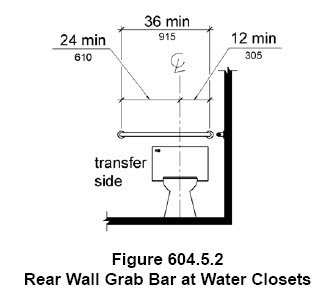
This is figure 604.5.2 from the 2010 ADA Standards. It shows the rear wall grab bar and its lcoation in relation to the toilet.
502 Parking
There are two sections that the ANSI has that the ADA does not: parallel parking and Electrical vehicle charging station parking.
502.9 Parallel Parking
The 2017 ANSI Standards has guidelines for parallel parking for on-street parking. It requires a vehicle space plus an access aisle parallel to the curb and a curb ramp or accessible route close to the spaces.
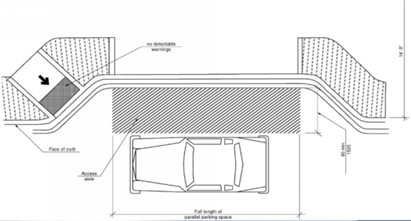
The figure 502.9.1 above shows on-street parallel parking
502.11 Electrical Vehicle Charging Stations
The 2017 ANSI Standards provide requirements for Electrical Vehicle charging stations. Some of them are
- Operable parts should be within reach
- There should be an access aisl adjacent to the parking space with clear floor sapce next to the unit
- Any protection bollards, curbs and wheel stops should not be located so it obstructs the route or the reaching.

Monday, January 4th, 2021
Where are accessible benches required?
Compliance with ADA Section 903 (Benches) shall be required only when specifically referenced in the 2010 ADA Standards for Accessible Design. This also applies to Texas 2012 Texas Accessibility Standards. There is no specific scoping for benches, except when they are required in the the different sections of the ADA Standards. Because the ADA Standards only deals with fixed or built in elements, benches must be fixed or built in as well.
Benches complying with section 903 are only required at the following spaces:
- Saunas (per section 612)
- Locker Rooms (per section 803)
- Dressing Rooms (per section 803)
- Fitting Rooms (per section 803)
- Holding Cells (807)
And all those benches must follow the requirements in section 903:
903.2 A Clear Floor or Ground Space next to the short axis.
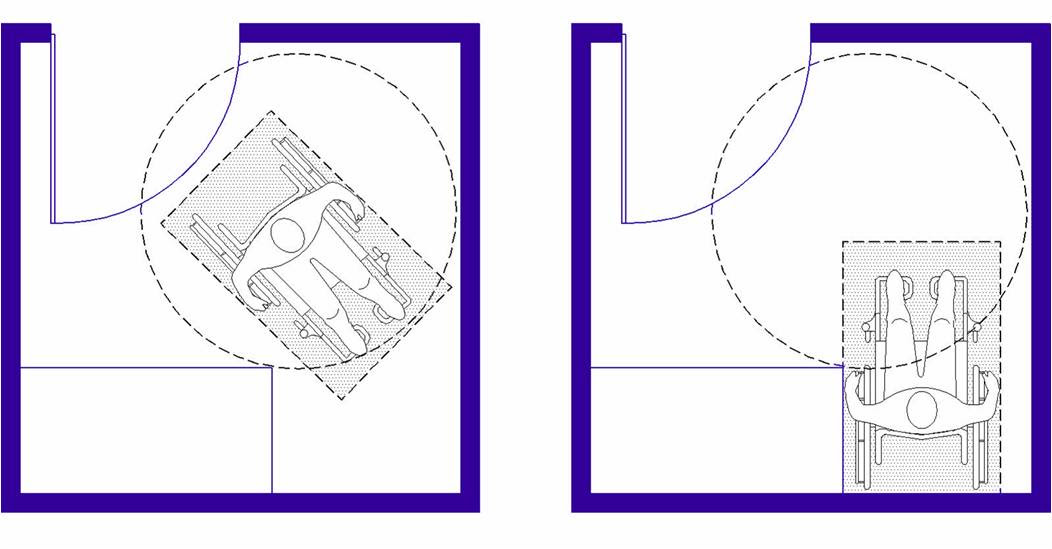
The bench shown in the figure above is inside a dressing room which requires that the bench have back support as well as the 30″x48″ clearance parallel with the short axis of the bench
903.3 Size should be 42″ long and between 20″ and 24″ deep
903.4 Back Support.
903.5 Height should be 17″-19″
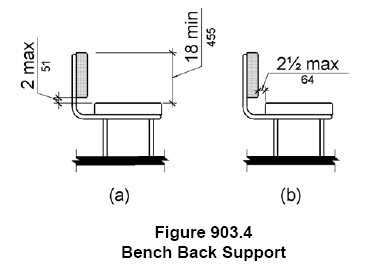
903.6 will holds 250 lbs
903.7 at Wet Locations the seat shall be slip resistant and does not accumulate water.
Saunas and Steam Rooms ADA 612.2

The sauna has a bench with back support, the proper length of 42″ and depth of 24″ with a 30″ x 48″ space next to its short axis
Dressing, Fitting, and Locker Rooms ADA 803.4
Dressing rooms are typically private rooms in doctor’s offices, imaging centers etc. which are provided for the purpose of changing out of clothes and into other garments

This dressing room does not have a compliant bench because the bench is movable, the door swings into it and no 30″ next to its short axis .
Fitting rooms are private rooms provided at retail stores for the purpose of trying on clothing for purchase.
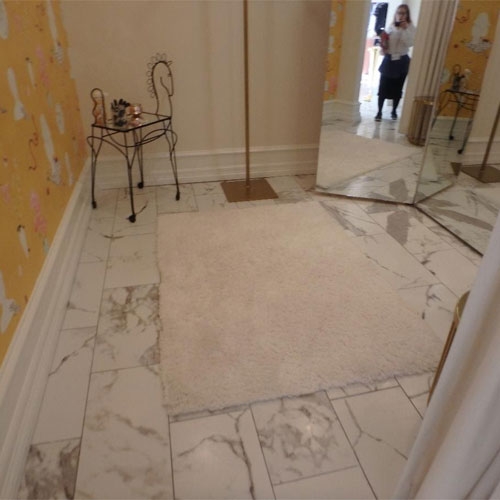
This dressing room does not have a compliant bench in the room.

This fitting room does not have a compliant bench because it doesn’t have a 30″ space next to the short axis
Locker rooms are also considered “dressing rooms” if the lockers are used to keep uniforms or clothing like at a gym or a medical building where people will change into clothes for a specific purpose.

This bench is located up against the wall in a locker room and therefore has back support. Note that the 30″x48″ clear floor space is in front of the door which (although not recommended) it is allowed

This locker room does not have a compliant bench. It lacks back support and it is not a minimum of 20″ deep.
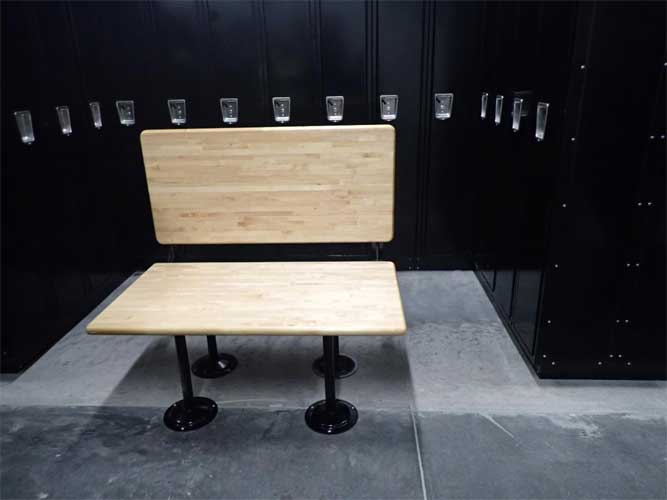
This is a bench that is not up against the wall so back support per figure 903.4 was provided, but they did not provide the 30″ x 48″ space next to the short axis. The lockers were in the way reducing the clearance to 21″ (see next photo)
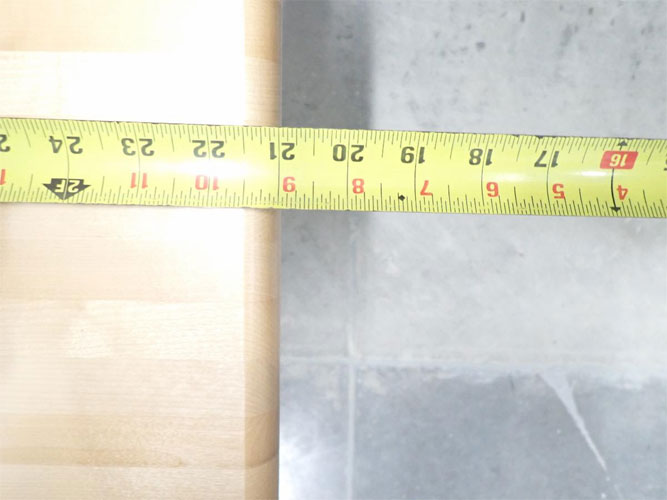
This photo is the dimension of 21″ between the edge of the bench and the edge of the lockers next to it. The clearance should have been 30″ minimum
Holding Cells and Housing Cells ADA 807.2.2
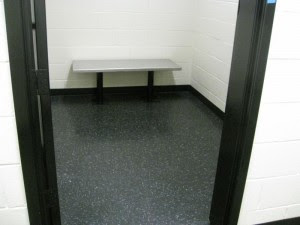
This holding cell has a bench with back support, but it does not have a 30″ clearance next to the short side.
Other Bench locations
There may be other locations where benches are used. If a fixed bench is provided in other spaces besides the ones specifically listed in the Standards, they do not have to comply with section 903. Below are other locations where benches may be provided, but do not have to comply with the standards or be on an accessible route.
Benches on the exterior
What about fixed or built in benches at courtyards, amphitheaters or or even at parks? If they are part of an assembly area (with four or more benches for the use of an audience or seating for spectators) then it would have to comply only with assembly seating per section 221 and 802.
Otherwise, these benches are not scoped and do not have to comply with the requirements in section 903.


The benches shown in the photos above are located in a park. These benches are not required to comply. Even the one at the basketball court is not considered assembly seating unless there are four or more and meant to be part of the spectator seating.
Benches at shower rooms
Shower rooms often have benches, but those are not required to comply because a shower room is not technically a “dressing” room even though dressing and undressing might occur inside.
Benches are different than shower seats. The photo below shows a shower with a bench but no seat.
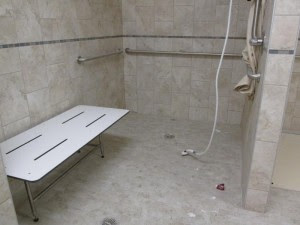
The bench shown in the photos above are located in a shower room. It is not inside the shower and therefore not considered a shower seat. Benches are not required in shower rooms and therefore do not have to comply with the Standards.
Bus stops also might have a bench
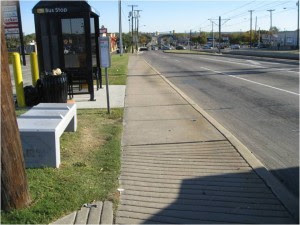
The bench adjacent to the bus stop and the one located inside the bus stop are not required to comply with either section 903 or section 802.
ADA only requires compliance in dressing rooms, fitting rooms, locker rooms, saunas, and holding cells. The spaces shown above are not required to provide a bench, therefore if a bench is provided it will not have to comply.
TDLR has a Technical Memo that explains this fact.
Friday, October 2nd, 2020
Introduction
This month’s newsletter we are excited to speak to Ms. Marsha Godeaux from TDLR where she will be clarifying a common question they receive. It has to do with the reach range over obstructions and clear floor spaces below the obstruction.
The 2010 ADA Standards and the 2012 TAS (even the 2009 ICC ANSI A117.1) has a requirement that the depth of the clear floor space below an obstruction should equal the high reach range over an obstruction.
308.2.2 Obstructed High Reach. Where a high forward reach is over an obstruction, the clear floor space shall extend beneath the element for a distance not less than the required reach depth over the obstruction.

Therefore if we have to reach to a faucet, or a soap dispenser mounted behind the sink then we are also required to have the same amount of space at the floor directly under the operable part.
And the way we measure the clear floor space is to use the figure showing the toe clearance. The 30″x48″ clear floor space should be measured from the operable part above and must be no deeper than 25″ and no less than 17″.
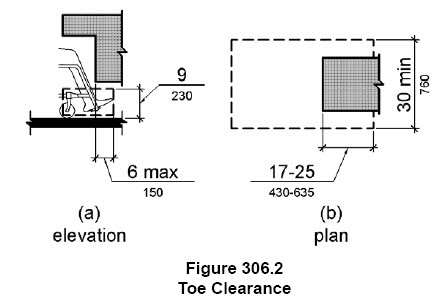
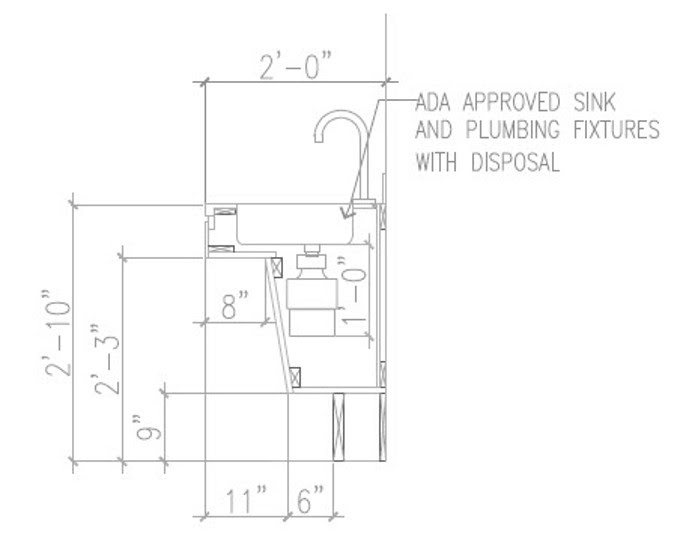
This sink section shows all the correct knee and toe clearance but it also shows a piece of blocking at the base board which measures 17″. Unless the faucet is also at 17″ from the edge of the counter, this detail does not provide the correct amount of clear floor space under the sink to allow for the reach range to the faucet.
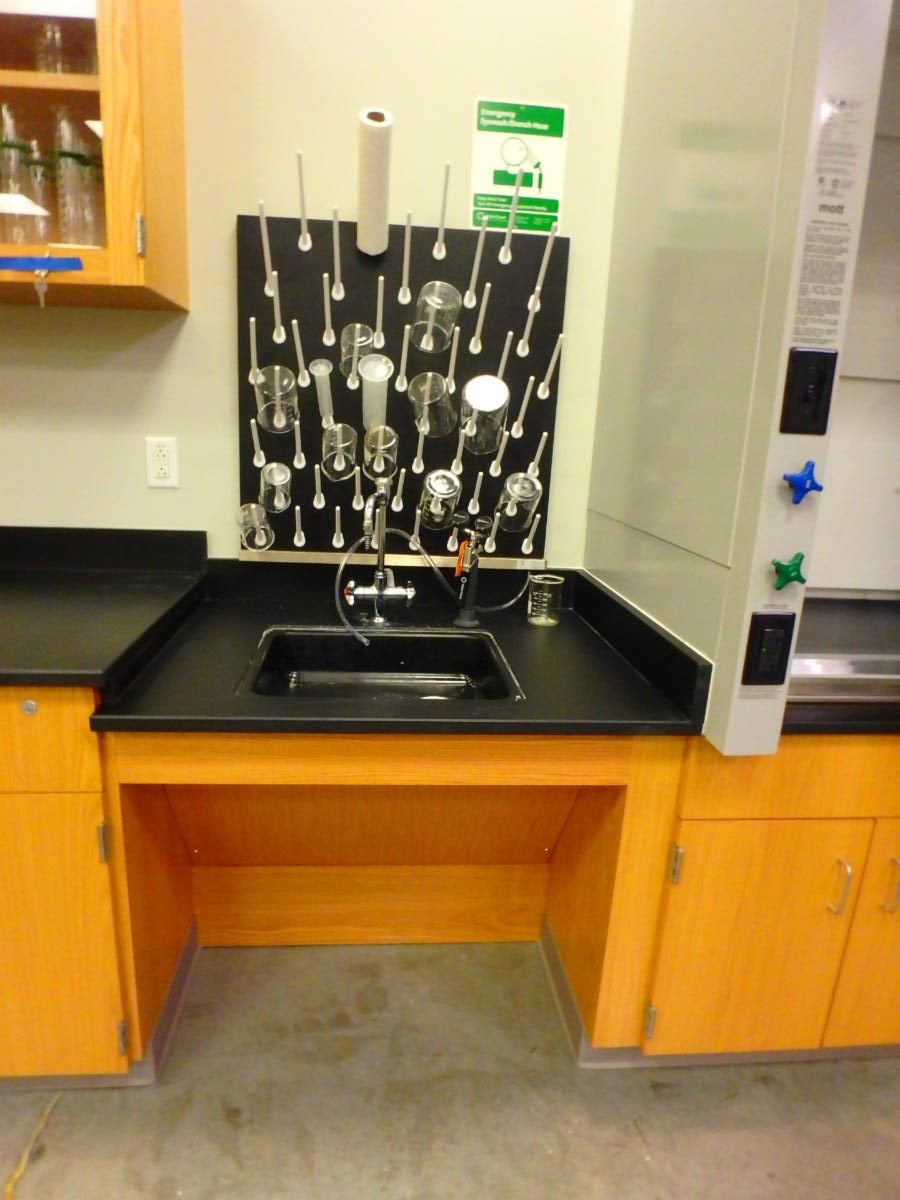
This sink was built in a similar design as the detail with only 17″ of depth at the toe clearance, which was not enough clear floor space for the high reach required to the faucet or the test tube racks or even the outlet behind the sink.

This clear floor space was only 17″
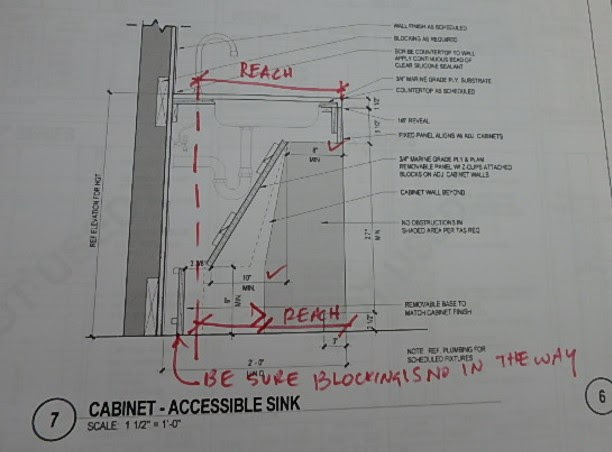
This section shows the relationship between the high reach above and the clear floor space below.

This lavatory has a faucet 20″ from the edge of the counter.
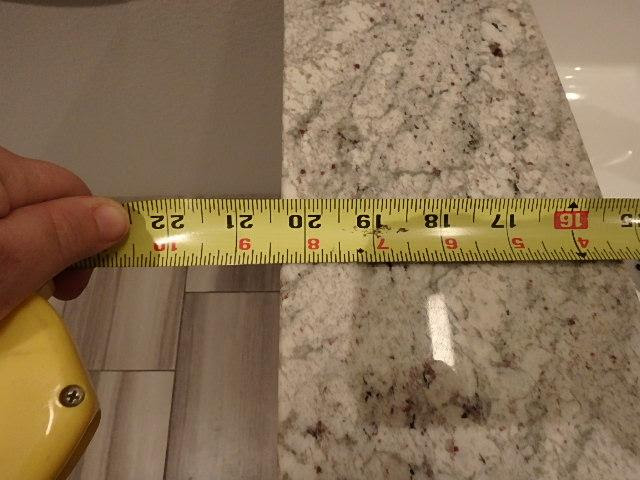
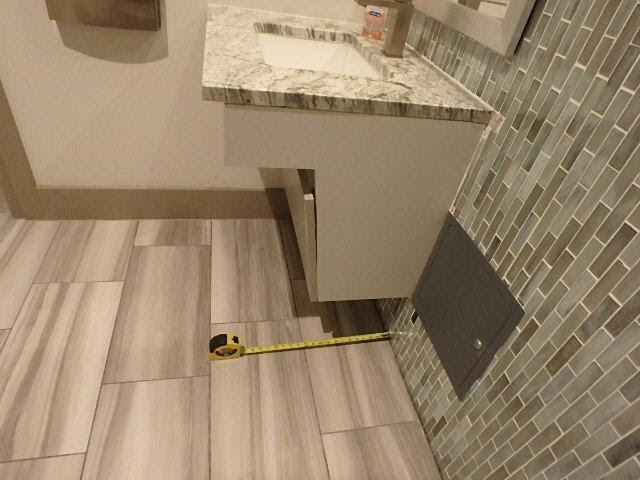
The clear floor space below the lavatory is more than 20″ from the operable part which is compliant.
The reach range at the sink or lavatories should always be a forward approach even though high reach can also be parallel.
So to summarize, the amount of depth required to reach an operable part above a sink or lavatory (such as faucets, soap dispensers, paper towel dispensers, electric outlets etc) should have an equal or greater amount of clear floor space below the operable part.
Tuesday, September 1st, 2020
Introduction
In Texas, Beginning Aug. 1, 2020, a new rule from The Texas Department of Licensing of Regulation relating to markings and signage required for Accessible Parking Spaces went into effect. Rule 68.104 (Texas Administrative Code) implements House Bill 3163, passed by the 86th Texas Legislature in 2019. The Elimination of Architectural Barriers (EAB) Advisory Committee recommended adoption of the rule during its June 15, 2020 meeting, and it was adopted by the Texas Commission of Licensing and Regulation at their June 30, 2020, meeting.
All projects registered with TDLR on or after August 1, 2020 must comply with the rule, as well as Texas Accessibility Standards requirements related to parking spaces. Any new or alteration construction projects that begin on or after August 1, 2020 (including those that do not meet the $50,000 threshold requiring registration with TDLR), must also satisfy the rule if they include accessible parking requirements. Rule 68.104 is available on TDLR’s Elimination of Architectural Barriers webpage.
Rule 68.104 is available on TDLR’s Elimination of Architectural Barriers webpage.

68.104. Accessible Parking Spaces.
(New section effective August 1, 2020, 45 TexReg 5166)
- (a) A paved accessible parking space must include:
- (1) the International Symbol of Accessibility painted conspicuously on the surface in a color that contrasts the pavement;
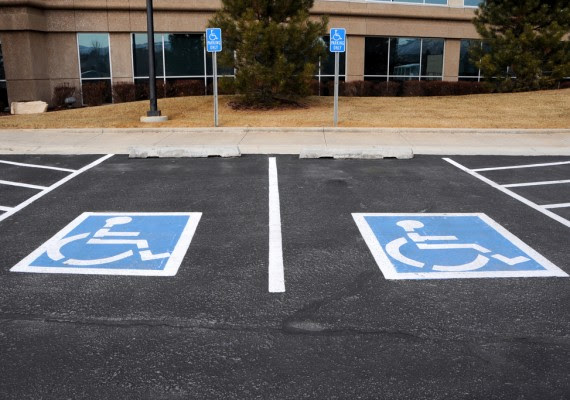
(2) the words “NO PARKING” painted on any access aisle adjacent to the parking space. The words must be painted:
- in all capital letters;
- with a letter height of at least twelve inches, and a stroke width of at least two inches; and
- centered within each access aisle adjacent to the parking space and;

These images are from California Code Title 24 but it is very close to what TDLR is requiring
(3) a sign identifying the consequences of parking illegally in a paved accessible parking space. The sign must:
- at a minimum state “Violators Subject to Fine and Towing” in a letter height of at least one inch;
- be mounted on a pole, post, wall or freestanding board;

- be no more than eight inches below a sign required by Texas Accessibility Standards, 502.6; and
- be installed so that the bottom edge of the sign is no lower than 48 inches and no higher than 80 inches above ground level.
- (b) A parking space identification sign that complies with Texas Accessibility Standards, 502.6, that includes the requirements in subsection (a)(3)(A) satisfies subsection (a)(3).

This sign complies with TAS 502.6 which is acceptable for the new requirements
Need Barrier Free CEUs?
Monday, February 3rd, 2020
There are a few of requirements in the 2010 ADA Standards that speak about ways that people get around. Some are described as either “circulation path”, “path of travel”, “accessible route” or “vehicular path”. Those all speak about either a car, wheelchair or pedestrian means of getting different places. In my experience, there is a misunderstanding about the difference between “circulation path” and “path of travel” and “accessible route”.
Path of Travel and Accessible route are mainly describing the “unobstructed” path that a wheelchair user would take.

But a circulation path is speaking about a path where any pedestrian would use to get around. As it pertains to Americans with disabilities, this term is used for persons who are visually impaired, but are still able to walk.

The idea is that a person who cannot see very well cannot detect certain hazards along the path that he will take to find his way around (i.e. the circulation path). This newsletter will discuss this concept and will give examples of some “circulation paths”
Protruding Objects
When a person who is visually impaired is walking to find their way, that is a description of his or her “circulation path”. Since they cannot see, we are required to make sure there are no hazards along their path. Those hazards are any objects located along the circulation path that are mounted higher than 27″ a.f.f. or lower than 80″ a.f.f. and projects more than 4″ onto the path.

….because the bar is a protruding object
A protruding object, cannot be detected by a cane which is one of the ways that a person who is visually impaired finds their way. Here is a video by the US Access Board that explains this topic.
Circulation Path
What becomes confusing for people is the other terms in the standard. What is a circulation path? What is an accessible route? What is a path of travel? A circulation path is different than an accessible route. An accessible route is solely for people in wheelchairs. It must be a certain width and should be located so that people in wheelchairs can use it without much effort.
A circulation path, on the other hand, can be used by anyone. It describes the path that a person who can walk will be taking. And that can really be anywhere that leads you from one place to another. Below are some examples:
The obvious circulation path is a corridor. That is what most people think of when they see the words “circulation path”. Along a corridor, make sure the sconces are not mounted lower than 80″ a.f.f. if they are deeper than 4″.

A corridor is a circulation path.
A circulation path can be anywhere where people are walking. So from one side of the bar shown below to the other side is a circulation path and the counter should not project more than 4″ onto it.

The bar top projects more than 4″ onto the circulation path between one side of the bar to the other.
The path to the restroom door is a circulation path. The paper towel dispenser is mounted along that path and it is deeper than 4″, therefore it is a protruding object.

The paper towel dispenser in the restroom is located along the circulation path.
The circulation path to the desk has a display cabinet that projects more than 4″ onto it.
 The display case is located in the circulation path to the desk.
The display case is located in the circulation path to the desk.
The path to the restroom door is considered the circulation path. The drinking fountain is located on the circulation path of that door and it is a protruding object.

The drinking fountain projects more than 4″ onto the circulation path to the restroom door.
The drinking fountain in the photo below is also located along the circulation path too the restroom door. It is partially recessed, but since the bottle filler is not the same depth as the drinking fountain it does not provide cane detection.

The drinking fountain is located along the circulation path to get to the door beyond.
The circulation path to the lavatory has a hand dryer projecting onto it.

The path to the lavatory is the circulation path.
Any place in a plaza where people walk is part of a circulation path. The sculpture is located within the circulation path and the angled parts come down to less than 80″ a.f.f. and are considered protruding objects.

The planters were added at each angle as cane detection.
When discussing circulation paths, keep in mind that although an accessible route is a circulation path because that is where wheelchairs will go, a circulation path is not an accessible route. A circulation path is where ANYONE can go. There may be many more examples of circulation paths, so let’s keep them free from hazards and protruding objects.
 Abadi
Abadi 










































































































 The display case is located in the circulation path to the desk.
The display case is located in the circulation path to the desk.


